Impact of Processing Conditions on Rheology, Tribology and Wet Lubrication Performance of a Novel Amino Lipid Hair Conditioner
Abstract
:1. Introduction
1.1. Processing Effects on Emulsion Formation
1.2. Rheological Profiling
1.3. Tribological Characterization and Wet Lubrication Performance of Hair Conditioners
2. Materials and Methods
2.1. Materials
2.2. Methods
2.2.1. Wet-Lubrication Conditioning Performance of AminoSensyl™ in Contrast to Alkyl Quats
- First, the tress is dipped in a beaker of warm tap water for 10 s.
- Then, 1 mL of 50% Sodium Laureth Sulfate, SLES (Lubrizol corporation, Cleveland, OH, USA) solution is dispensed on the tress using a pipette and the tress is washed in gentle strokes in the direction of the hair cuticle using the finger pads. The tress is then rinsed with warm water for 20 s. This process is repeated to remove all traces of SLES.
- The tress is then dried using a handheld dryer (Revlon hair tools, El Paso, TX, USA) and combed through five (5) times to remove all knots and tangles.
- The tress is then dipped in warm water to re-wet and the initial wet combing force is measured. This re-wetting step is important after the combing step as we want to study the wet lubrication performance of the formulations since wet hair is more susceptible to breakage on combing [1].
- 2 g of conditioner sample is applied and rubbed into the tress for 20 s and the force required to comb through the hair with conditioner applied is measured.
- The product is left in the hair for 10 min, rinsed off with cold water and the final combing force after conditioner application is measured.
- The reduction in combing force is expressed as a percentage of the initial wet combing force measured before conditioner application, using the formula (Equation (1)):
2.2.2. Effects of Shear Mixing Rate on Formulation Performance
3. Results and Discussion
3.1. Conditioning Performance of AminoSensyl™ in Contrast to Alkyl Quats
3.2. Effects of Shear Mixing Speed on Formulation Performance
3.2.1. Rheological Profiling
3.2.2. Tribological Profiling
4. Conclusions
Author Contributions
Funding
Institutional Review Board Statement
Informed Consent statement
Data Availability Statement
Acknowledgments
Conflicts of Interest
References
- Draelos, Z.D. Hair Care: An Illustrated Dermatologic Handbook; Taylor & Francis Group: Oxfordshire, UK, 2005. [Google Scholar]
- Bhushan, B. Biophysics of Human Hair: Structural, Nanomechanical, and Nanotribological; Springer: Berlin/Heidelberg, Germany, 2010. [Google Scholar]
- LaTorre, C.; Bhushan, B. Investigation of scale effects and directionality dependence on friction and adhesion of human hair using AFM and macroscale friction test apparatus. Ultramicroscopy 2006, 106, 720–734. [Google Scholar] [CrossRef]
- Bhushan, B. Nanoscale characterization of human hair and hair conditioners. Prog. Mater. Sci. 2008, 53, 585–710. [Google Scholar] [CrossRef]
- Fernández-Peña, L.; Guzmán, E. Physicochemical aspects of the performance of hair-conditioning formulations. Cosmetics 2020, 7, 26. [Google Scholar] [CrossRef] [Green Version]
- Cruz, C.F.; Fernandes, M.; Gomes, A.; Coderch, L.; Marti, M.; Méndez, S.; Gales, L.; Azoia, N.G.; Shimanovich, U.; Cavaco-Paulo, A. Keratins and lipids in ethnic hair. Int. J. Cosmet. Sci. 2013, 35, 244–249. [Google Scholar] [CrossRef] [PubMed] [Green Version]
- Wagner, E.L.; Shin, J.-B. Mechanisms of hair cell damage and repair. Trends Neurosci. 2019, 42, 414–424. [Google Scholar] [CrossRef]
- Groves, A.K. The challenge of hair cell regeneration. Exp. Biol. Med. 2010, 235, 434–446. [Google Scholar] [CrossRef] [Green Version]
- Davis, K. How to Repair Damaged Hair. Available online: https://www.medicalnewstoday.com/articles/how-to-repair-damaged-hair (accessed on 8 July 2021).
- Rosebrook, J. You Cannot Repair Damaged Hair. Available online: https://joshrosebrook.com/blogs/articles/91363463-you-cant-really-repair-or-heal-damaged-hair (accessed on 8 July 2021).
- Dias, M.F.R.G. Hair cosmetics: An overview. Int. J. Trichol. 2015, 7, 2–15. [Google Scholar] [CrossRef]
- Rathi, S.K.; D′souza, P. Shampoo and conditioners: What a dermatologist should know? Indian J. Dermatol. 2015, 60, 248–254. [Google Scholar] [CrossRef]
- Cruz, C.F.; Costa, C.C.; Gomes, A.C.; Matamá, T.; Cavaco-Paulo, A. Human hair and the impact of cosmetic procedures: A review on cleansing and shape-modulating cosmetics. Cosmetics 2016, 3, 26. [Google Scholar] [CrossRef] [Green Version]
- Gubitosa, J.; Rizzi, V.; Fini, P.; Cosma, P. Hair care cosmetics: From traditional shampoo to solid clay and herbal shampoo, a review. Cosmetics 2019, 6, 13. [Google Scholar] [CrossRef] [Green Version]
- Yu, Y.; Yang, W.; Wang, B.; Meyers, M.A. Structure and mechanical behavior of human hair. Mater. Sci. Eng. C 2017, 73, 152–163. [Google Scholar] [CrossRef]
- Mitsui, T. New Cosmetic Science; Elsevier: Amsterdam, The Netherlands, 1998. [Google Scholar]
- Paar, A. Surface Charge of Hair. Available online: https://wiki.anton-paar.com/en/surface-charge-of-hair/ (accessed on 8 July 2021).
- Lunn, A.C.; Evans, R.E. The Electrostatic Properties of Human Hair. J. Soc. Cosmet. Chem. 1977, 28, 549–569. [Google Scholar]
- Agredo, P.; Rave, M.C.; Echeverri, J.D.; Romero, D.; Salamanca, C.H. An evaluation of the physicochemical properties of stabilized oil-in-water emulsions using different cationic surfactant blends for potential use in the cosmetic industry. Cosmetics 2019, 6, 12. [Google Scholar] [CrossRef] [Green Version]
- Tadros, T. Encyclopedia of Colloid and Interface Science; Springer: Berlin/Heidelberg, Germany, 2013. [Google Scholar]
- Romanowski, P. What Kind of Surfactants Are Used in Cosmetics? Available online: https://chemistscorner.com/what-kinds-of-surfactants-are-used-in-cosmetics/?awt_m=1btTPK5y2uz&awt_email=oajayi01%40manhattan.edu (accessed on 9 July 2021).
- Becher, P. A review of: “Cationic Surfactants”: Physical Chemistry. D. N. Rubingh and P. M. Holland, eds. (Surfactant Science Series, Vol. 37). Marcel Dekker, Inc., New York and Basel, 1991. pp. vii + 527, $125.00. J. Dispers. Sci. Technol. 1991, 12, 548–549. [Google Scholar] [CrossRef]
- Anthony, J.; O’Lenick, J. Surfactants: Strategic Personal Care Ingredients; Allured Publishing Corporation: Carol Stream, IL, USA, 2014. [Google Scholar]
- O’Lenick, A. Anionic/cationic complexes in hair care. J. Cosmet. Sci. 2011, 62, 209–228. [Google Scholar]
- Yang, B.; Howe, A.; Paez, A.; Quadir, M. Evonik Researchers Detail the Benefits of an Eco-Friendly and Vegetable-Based Esterquat for Hair Conditioning and Skin Care Applications. Available online: https://www.happi.com/contents/view_features/2009-11-25/eco-friendly-vegetable-based-esterquat-from-e/ (accessed on 12 July 2021).
- Hora, P.I.; Pati, S.G.; McNamara, P.J.; Arnold, W.A. Increased Use of Quaternary Ammonium Compounds during the SARS-CoV-2 Pandemic and Beyond: Consideration of Environmental Implications. Environ. Sci. Technol. Lett. 2020, 7, 622–631. [Google Scholar] [CrossRef]
- Lim, C.I.; Biswas, W. An evaluation of holistic sustainability assessment framework for palm oil production in malaysia. Sustainability 2015, 7, 16561–16587. [Google Scholar] [CrossRef] [Green Version]
- Europe, Cosmetics. Good Sustainability Practice (Gsp) for the Cosmetic Industry. Available online: https://www.cosmeticseurope.eu/files/4214/6521/4452/GSP_Brochure.pdf (accessed on 12 July 2021).
- Sahota, A. Sustainability: How the Cosmetics Industry Is Greening Up; Sahota, A., Ed.; Wiley: Hoboken, NJ, USA, 2014. [Google Scholar]
- Bondi, S. Lipoprotein and the analysis of degenerative adiposis lipopeptides, their meaning, synthesis and characteristics (laurylglycin and laurylalanin). Z. Biochem. 1909, 17, 573. [Google Scholar]
- Rufino, R.D.; de Luna, J.M.; Campos-Takaki, G.M.; Sarubbo, L. Characterization and properties of the biosurfactant produced by Candida lipolytica UCP 0988. Electron. J. Biotechnol. 2014, 17, 34–38. [Google Scholar] [CrossRef] [Green Version]
- Infante, M.; Pinazo, A.; Seguer, J. Non-conventional surfactants from amino acids and glycolipids: Structure, preparation, and properties. Colloids Surf. A Physicochem. Eng. Asp. 1997, 123–124, 49–70. [Google Scholar] [CrossRef]
- Takehara, M. Properties and applications of amino acid-based surfactants. Colloids Surf. 1989, 38, 149–167. [Google Scholar] [CrossRef]
- Gallot, B.; Hassan, H.H. Lyotropic lipo-amino-acids: Synthesis and structural study. Mol. Cryst. Liq. Cryst. Inc. Nonlinear Opt. 1989, 170, 195–214. [Google Scholar] [CrossRef]
- Presenz, P. Lipoamino acids and lipopeptides as amphiphilic compounds. Pharmazie 1996, 10, 755–758. [Google Scholar]
- Joondan, N.; Laulloo, S.J.; Caumul, P. Amino acids: Building blocks for the synthesis of greener amphiphiles. J. Dispers. Sci. Technol. 2018, 39, 1550–1564. [Google Scholar] [CrossRef]
- Wu, M.-H.; Wan, L.-Z.; Zhang, Y.-Q. A novel sodium N-fatty acyl amino acid surfactant using silkworm pupae as stock material. Sci. Rep. 2014, 4, 4428. [Google Scholar] [CrossRef] [Green Version]
- Moran, M.D.C.; Pinazo, A.; Perez, L.; Clapes, P.; Angelet, M.; Garcia, M.T.; Vinardell, M.P.; Infante, M.R. “Green” amino acid-based surfactants. Green Chem. 2004, 6, 233–240. [Google Scholar] [CrossRef] [Green Version]
- Piera, E.; Comelles, F.; Erra, P.; Infante, M.R. New alquil amide type cationic surfactants from arginine. J. Chem. Soc. Perkin Trans. 1998, 2, 335–342. [Google Scholar] [CrossRef]
- Holmberg, K. Novel Surfactants: Preparation, Applications, and Biodegradability; Marcel Dekker, Inc.: New York, NY, USA, 2003. [Google Scholar]
- Pinazo, A.; Pons, R.; Perez, L.; Infante, M.R. Amino acids as raw material for biocompatible surfactants. Ind. Eng. Chem. Res. 2011, 50, 4805–4817. [Google Scholar] [CrossRef]
- Trivedi, T.J.; Rao, K.S.; Singh, T.; Mandal, S.K.; Sutradhar, N.; Panda, A.B.; Kumar, A. Task-specific, biodegradable amino acid ionic liquid surfactants. ChemSusChem 2011, 4, 604–608. [Google Scholar] [CrossRef]
- Tripathy, D.B.; Mishra, A.; Clark, J.; Farmer, T. Synthesis, chemistry, physicochemical properties and industrial applications of amino acid surfactants: A review. Comptes Rendus Chim. 2018, 21, 112–130. [Google Scholar] [CrossRef]
- Nnanna, I.A.; Xia, J. Protein-Based Surfactants: Synthesis, Physicochemical Properties, and Applications; Marcel Dekker, Inc.: New York, NY, USA, 2001. [Google Scholar]
- Perez, L.; Pinazo, A.; Rosen, M.J.; Infante, M.R. Surface activity properties at equilibrium of novel gemini cationic amphiphilic compounds from arginine, Bis(Args). Langmuir 1998, 14, 2307–2315. [Google Scholar] [CrossRef]
- Clapés, P.; Morán, C.; Infante, M.R. Enzymatic synthesis of arginine-based cationic surfactants. Biotechnol. Bioeng. 1999, 63, 333–343. [Google Scholar] [CrossRef]
- Singare, P.U.; Mhatre, J.D. Cationic surfactants from arginine: Synthesis and physicochemical properties. Am. J. Chem. 2012, 2, 186–190. [Google Scholar] [CrossRef] [Green Version]
- Colomer, A.; Pinazo, A.; Manresa, A.; Vinardell, M.P.; Mitjans, M.; Infante, M.R.; Perez, L. Cationic surfactants derived from lysine: Effects of their structure and charge type on antimicrobial and hemolytic activities. J. Med. Chem. 2011, 54, 989–1002. [Google Scholar] [CrossRef]
- Pinazo, A.; Wen, X.; Perez, L.; Infante, M.-R.; Franses, E.I. Aggregation behavior in water of monomeric and gemini cationic surfactants derived from arginine. Langmuir 1999, 15, 3134–3142. [Google Scholar] [CrossRef]
- Weihs, D.; Danino, D.; Pinazo-Gassol, A.; Perez, L.; Franses, E.I.; Talmon, Y. Self-aggregation in dimeric arginine-based cationic surfactants solutions. Colloids Surf. A Physicochem. Eng. Asp. 2005, 255, 73–78. [Google Scholar] [CrossRef]
- Shukla, D.; Tyagi, V. Cationic gemini surfactants: A review. J. Oleo Sci. 2006, 55, 381–390. [Google Scholar] [CrossRef] [Green Version]
- Happi. Suppliers Corner: Inolex Expands Aminosensyl Range. Available online: https://happi.texterity.com/happi/august_2019/MobilePagedArticle.action?articleId=1511553#articleId1511553 (accessed on 17 July 2021).
- Inolex. Amino Lipid Technology: Aminosensyl. Available online: https://inolex.com/pc/Products/Amino-Lipid-Technology/AminoSensyl-HC (accessed on 17 July 2021).
- Fevola, M.J. 100% natural and high performance conditioning: The next innovation in amino-acid based cationic ingredients. In In-Cosmetics Global; In-Cosmetics: Paris, France, 2019. [Google Scholar]
- Anastas, P.T.; John, C.W. Green Chemistry: Theory and Practice; Oxford University Press: Oxford, UK; New York, NY, USA, 1998. [Google Scholar]
- Burgo, R. Non-Petrochemically Derived Cationic Emulsifiers that Are Neutralized Amino Acid Esters and Related Compositions and Methods. European Patent EP3300717A1 47, 23 September 2020. [Google Scholar]
- Kim, K.-M.; Oh, H.M.; Lee, J.H. Controlling the emulsion stability of cosmetics through shear mixing process. Korea-Aust. Rheol. J. 2020, 32, 243–249. [Google Scholar] [CrossRef]
- Cunningham, G.E.; Alberini, F.; Simmons, M.J.; O’Sullivan, J.J. Understanding the effects of processing conditions on the formation of lamellar gel networks using a rheological approach. Chem. Eng. Sci. 2021, 242, 116752. [Google Scholar] [CrossRef]
- Davies, A.R.; Amin, S. Microstructure design of CTAC:FA and BTAC:FA lamellar gels for optimized rheological performance utilizing automated formulation platform. Int. J. Cosmet. Sci. 2020, 42, 259–269. [Google Scholar] [CrossRef] [PubMed]
- Eccleston, G.M. Emulsions and creams. In Aulton’s Pharmaceutics, the Design and Manufacture of Medicines; Elsevier: Amsterdam, The Netherlands, 2013; pp. 435–464. Available online: https://clinicalgate.com/emulsions-and-creams/ (accessed on 24 August 2021).
- Mysels; Mukerjee, P.; Karol, J. Critical Micelle Concentrations of Aqueous Surfactant Systems; US Government Print Office: Washington, DC, USA, 1971. [Google Scholar]
- Perez, L.; Infante, M.; Pons, R.; Moran, M.D.C.; Vinardell, P.; Mitjans, M.; Pinazo, A. A synthetic alternative to natural lecithins with antimicrobial properties. Colloids Surf. B Biointerfaces 2004, 35, 235–242. [Google Scholar] [CrossRef] [Green Version]
- Perez, L.; Pinazo, A.; Garcia, M.T.; Moran, M.D.C.; Infante, M.R. Monoglyceride surfactants from arginine: Synthesis and biological properties. New J. Chem. 2004, 28, 1326–1334. [Google Scholar] [CrossRef] [Green Version]
- Infante, R.; Dominguez, J.G.; Erra, P.; Julia, R.; Prats, M. Surface active molecules: Preparation and properties of long chain Nα-Acyl-L-A-Amino-Ω-Guanidine alkyl acid derivatives. Int. J. Cosmet. Sci. 1984, 6, 275–282. [Google Scholar] [CrossRef] [PubMed]
- Faustino, C.M.; Calado, A.R.; Garcia-Rio, L. Mixed micelle formation between amino acid-based surfactants and phospholipids. J. Colloid Interface Sci. 2011, 359, 493–498. [Google Scholar] [CrossRef]
- Akatsuka, H.; Yamamoto, M.; Ohara, Y.; Otsubo, Y. Effect of polyols on the shear-induced structure and rheological properties of behenyl trimethyl ammonium chloride/1-octadecanol/water ternary systems. Colloids Surf. A Physicochem. Eng. Asp. 2008, 326, 169–174. [Google Scholar] [CrossRef]
- Łuczak, A.; Fryzlewicz-Kozak, B. Methods of research into hair conditioners stability. Tech. Trans. Chem. 2013, 1, 29–38. [Google Scholar]
- Nakarapanich, J.; Barameesangpet, T.; Suksamranchit, S.; Sirivat, A.; Jamieson, A.M. Rheological properties and structures of cationic surfactants and fatty alcohol emulsions: Effect of surfactant chain length and concentration. Colloid Polym. Sci. 2001, 279, 671–677. [Google Scholar] [CrossRef]
- Eccleston, G. Multiple-Phase Oil-in-Water Emulsion. J. Soc. Cosmet Chem. 1990, 41, 1–22. [Google Scholar]
- Sakamoto, K.; Lochhead, R.Y.; Maibach, H.I.; Yamashita, Y. Cosmetic Science and Technology: Theoretical Principles and Applications; Elsevier: Amsterdam, The Netherlands, 2017. [Google Scholar]
- Yamagata, Y.; Senna, M. Change in viscoelastic behaviors due to phase transition of the assembly comprising cetyltrimethylammonium chloride/cetyl alcohol/water. Langmuir 1999, 15, 4388–4391. [Google Scholar] [CrossRef]
- Datta, A.; Tanmay, V.S.; Tan, G.X.; Reynolds, G.W.; Jamadagni, S.N.; Larson, R.G. Characterizing the rheology, slip, and velocity profiles of lamellar gel networks. J. Rheol. 2020, 64, 851–862. [Google Scholar] [CrossRef]
- Karl, W.; Perla, R.; Gérard, C.; Franck, C.; Luc, N.-M.; Hayat, B.; Denis, F. Effect of surfactant on structure thermal behavior of cetyl stearyl alcohols. J. Therm. Anal. Calorim. 2015, 123, 1411–1417. [Google Scholar] [CrossRef]
- Eccleston, G.M. The microstructure of semi-solid creams. Pharm. Int. 1986, 7, 63–70. [Google Scholar]
- Walstra, P. Physical Chemistry of Foods; CRC Press: Boca Raton, FL, USA, 2003. [Google Scholar]
- Colafemmina, G.; Palazzo, G.; Mateos, H.; Amin, S.; Fameau, A.-L.; Olsson, U.; Gentile, L. The cooling process effect on the bilayer phase state of the CTAC/cetearyl alcohol/water surfactant gel. Colloids Surf. A Physicochem. Eng. Asp. 2020, 597, 124821. [Google Scholar] [CrossRef]
- Choplin, L.; Marchal, P. Mixer-type rheometry. In Rheology—Encyclopedia of Life Support Systems; EOLSS: Paris, France, 2010; Volume 2. [Google Scholar]
- Ichihara, K.; Sugahara, T.; Akamatsu, M.; Sakai, K.; Sakai, H. Rheology of α-Gel Formed by Amino Acid-Based Surfactant with Long-Chain Alcohol: Effects of Inorganic Salt Concentration. Langmuir 2021, 37, 7032–7038. [Google Scholar] [CrossRef] [PubMed]
- Douaire, M.; Stephenson, T.; Norton, I. Soft tribology of oil-continuous emulsions. J. Food Eng. 2014, 139, 24–30. [Google Scholar] [CrossRef]
- Upadhyay, R.; Chen, J. Smoothness as a tactile percept: Correlating ‘oral’ tribology with sensory measurements. Food Hydrocoll. 2019, 87, 38–47. [Google Scholar] [CrossRef]
- Lee, S.; Heuberger, M.; Rousset, P.; Spencer, N.D. A Tribological Model for Chocolate in the Mouth: General Implications for Slurry-Lubricated Hard/Soft Sliding Counterfaces. Tribol. Lett. 2004, 16, 239–249. [Google Scholar] [CrossRef]
- De Vicente, J.; Spikes, H.A.; Stokes, J.R. Viscosity ratio effect in the emulsion lubrication of soft EHL contact. J. Tribol. 2006, 128, 795–800. [Google Scholar] [CrossRef]
- Dresselhuis, D.; De Hoog, E.; Stuart, M.C.; Van Aken, G. Application of oral tissue in tribological measurements in an emulsion perception context. Food Hydrocoll. 2008, 22, 323–335. [Google Scholar] [CrossRef]
- Chen, J.; Stokes, J. Rheology and tribology: Two distinctive regimes of food texture sensation. Trends Food Sci. Technol. 2012, 25, 4–12. [Google Scholar] [CrossRef]
- Meyer, F.; Oldorp, K. Rheological and Textural Properties of Various Food Formulations Analyzed with a Modular Rheometer Setup; Thermo Fisher Scientific: Waltham, MA, USA, 2021. [Google Scholar]
- Newman, W.; Cohen, G.L.; Hayes, C. A quantitative characterization of combing force. J. Soc. Cosmet. Chem. 1973, 24, 773–782. [Google Scholar]
- Liu, E.-H.; McGrath, K. Emulsion microstructure and energy input, roles in emulsion stability. Colloids Surf. A Physicochem. Eng. Asp. 2005, 262, 101–112. [Google Scholar] [CrossRef]
- Choi, J.; Hong, J.; Park, K.; Kim, G.; Han, Y.; Kim, S.; Kim, H. Role of chain length and type on the adsorption behavior of cationic surfactants and the silica floatability. Mater. Trans. 2014, 55, 1344–1349. [Google Scholar] [CrossRef] [Green Version]
- Pal, R. Shear Viscosity Behavior of Emulsions of Two Immiscible Liquids. J. Colloid Interface Sci. 2000, 225, 359–366. [Google Scholar] [CrossRef] [PubMed]
- Chen, T. Rheological Techniques for Yield Stress Ananlysis. TA Instruments Applications Note (RH025). Available online: https://www.tainstruments.com/applications-library-search/ (accessed on 15 July 2021).
- TA Instruments. Analysis of Chocolate Using Tribo-Rheometry and Its Correlation to Mouth-Feel; TA Instruments: New Castle, DE, USA, 2016. [Google Scholar]
- Stokes, J.; Boehm, M.; Baier, S.K. Oral processing, texture and mouthfeel: From rheology to tribology and beyond. Curr. Opin. Colloid Interface Sci. 2013, 18, 349–359. [Google Scholar] [CrossRef] [Green Version]
- De Wijk, R.A.; Prinz, J.F. The role of friction in perceived oral texture. Food Qual. Prefer. 2005, 16, 121–129. [Google Scholar] [CrossRef]

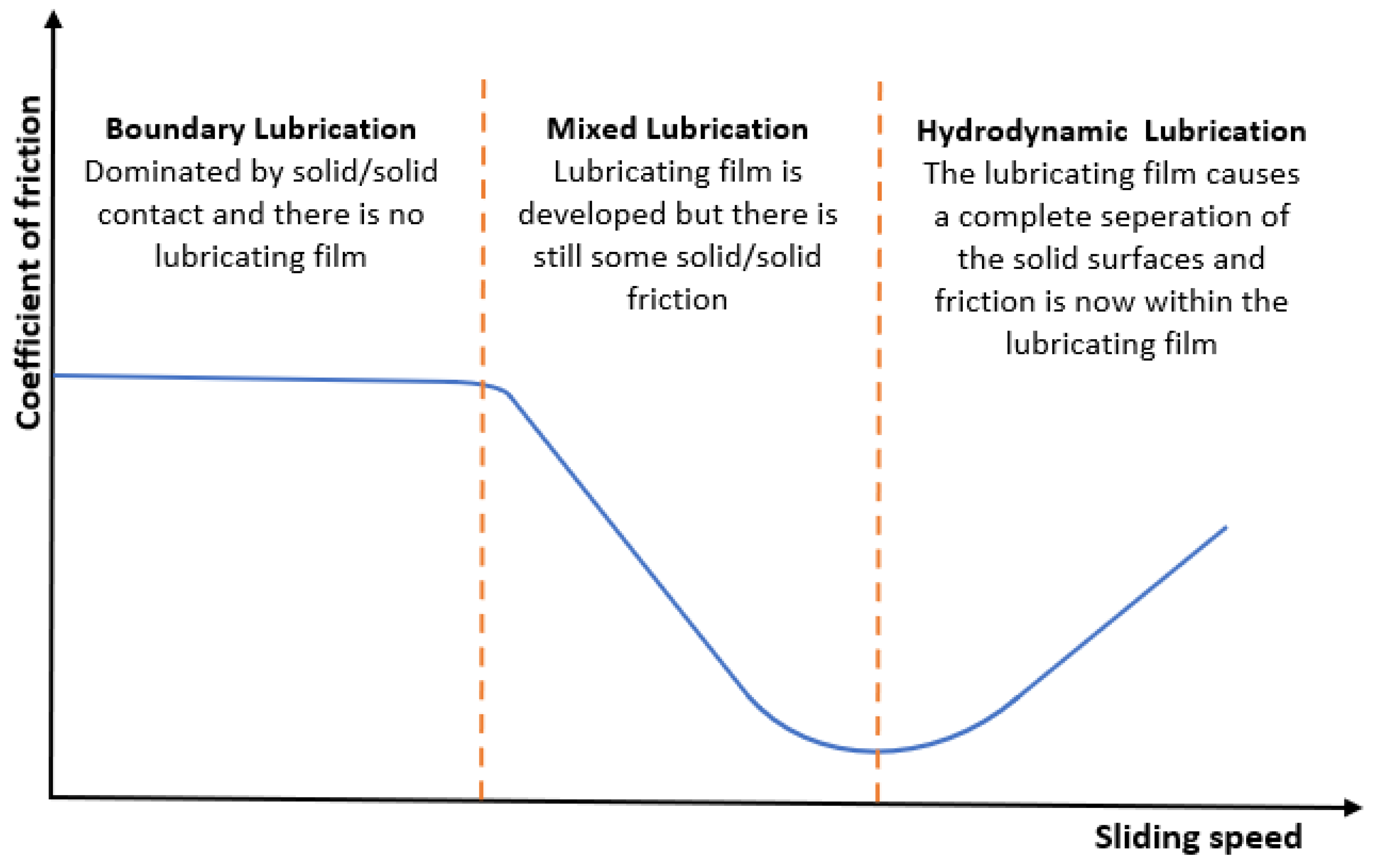

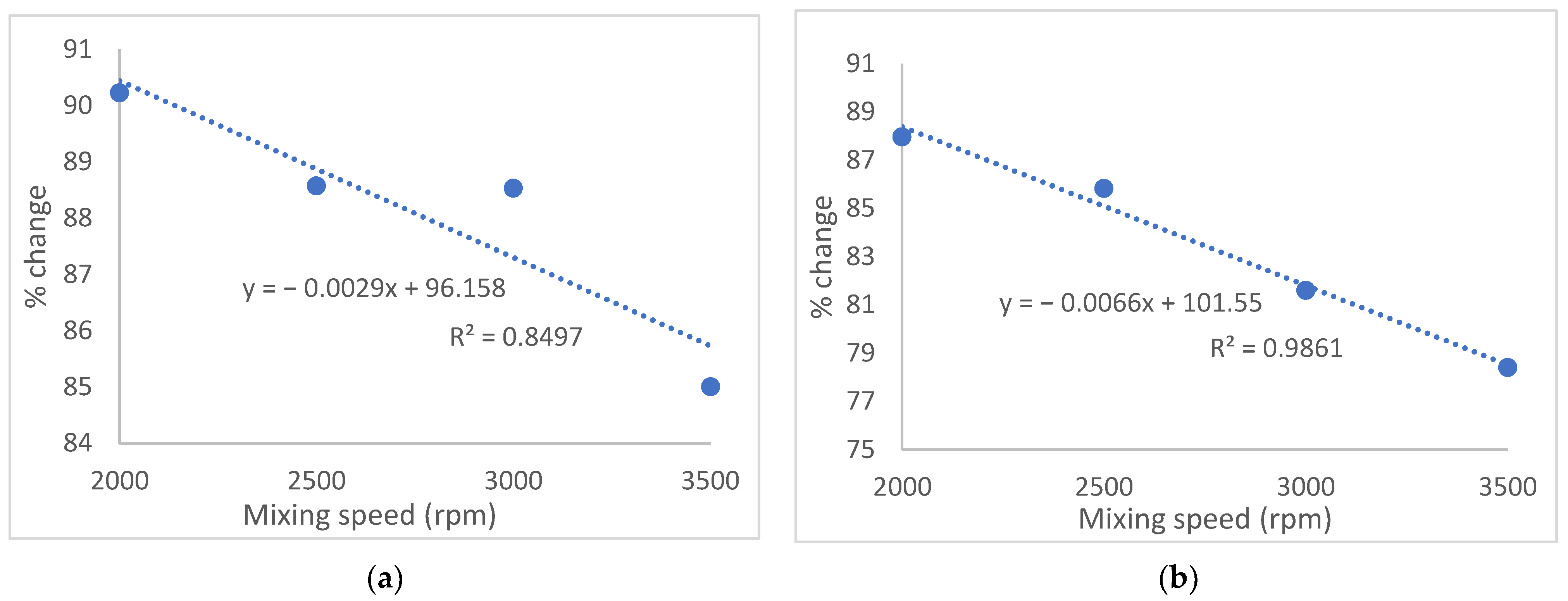
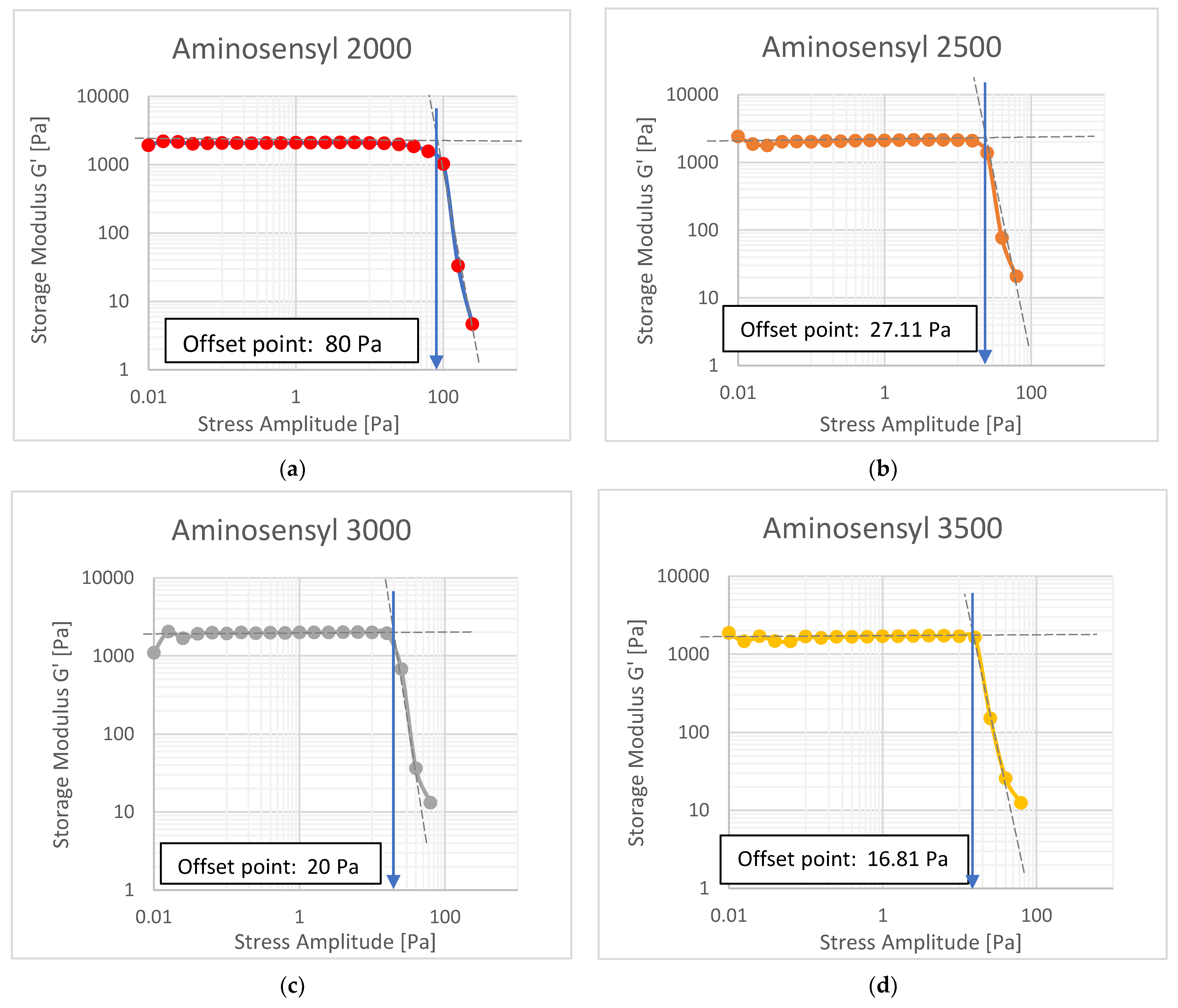
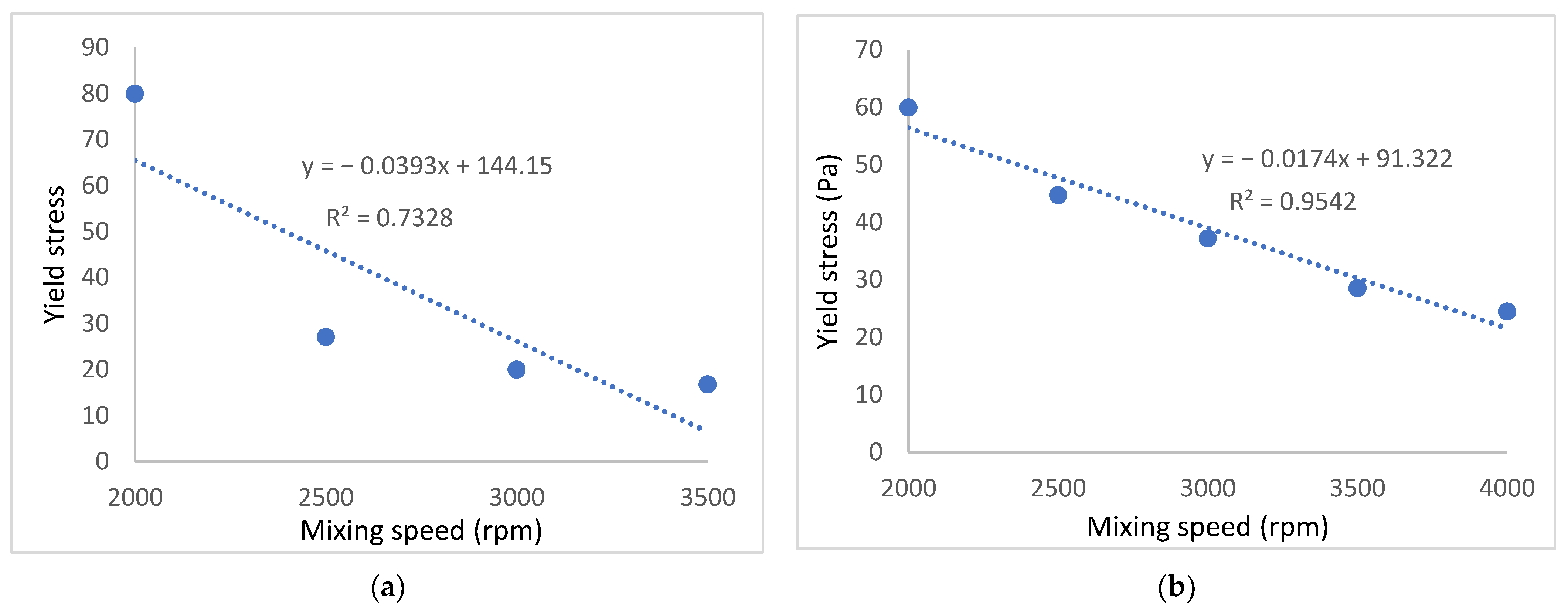
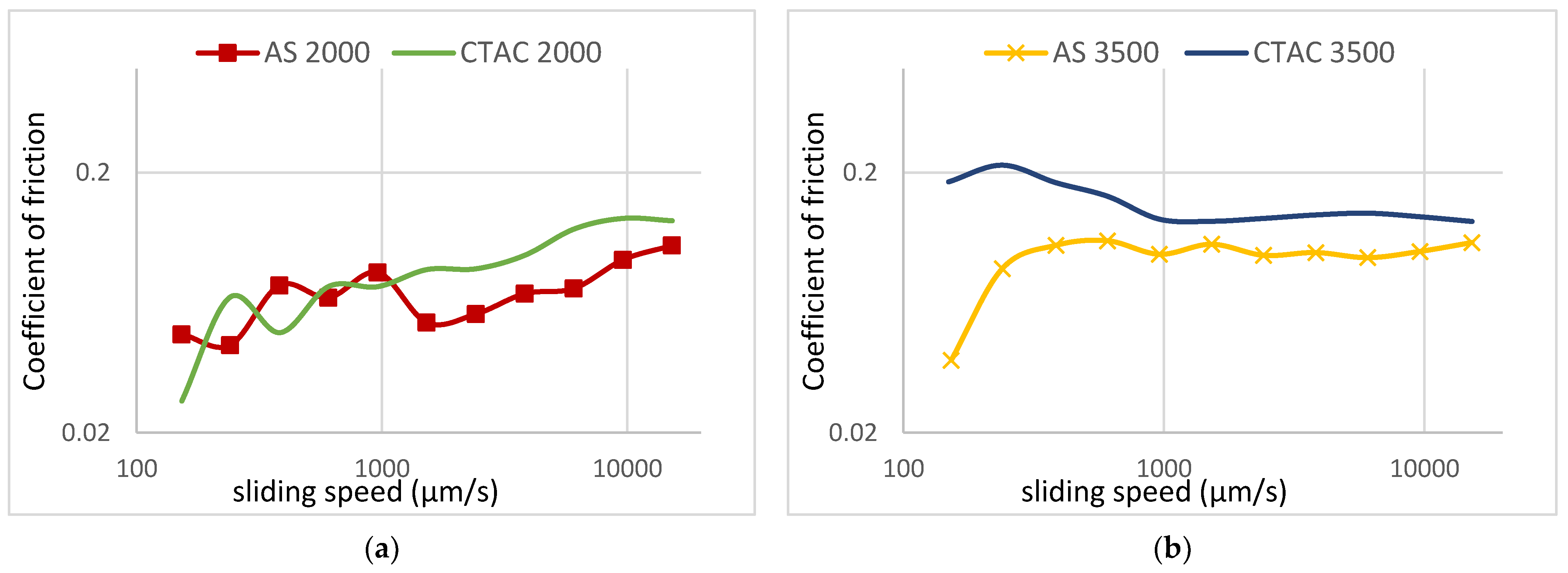
| AS:FA Ratio (wt%) | 6:10 | 10:10 | 10:6 |
|---|---|---|---|
| Wet initial | 1492.9 | 1391.1 | 232.8 |
| With Conditioner | 43.8 | 37.8 | 24.7 |
| Wet post-rinse | 32.7 | 38 | 50.8 |
| Reduction in wet combing force (%) | 97.8 | 97.2 | 78.2 |
Publisher’s Note: MDPI stays neutral with regard to jurisdictional claims in published maps and institutional affiliations. |
© 2021 by the authors. Licensee MDPI, Basel, Switzerland. This article is an open access article distributed under the terms and conditions of the Creative Commons Attribution (CC BY) license (https://creativecommons.org/licenses/by/4.0/).
Share and Cite
Ajayi, O.; Davies, A.; Amin, S. Impact of Processing Conditions on Rheology, Tribology and Wet Lubrication Performance of a Novel Amino Lipid Hair Conditioner. Cosmetics 2021, 8, 77. https://doi.org/10.3390/cosmetics8030077
Ajayi O, Davies A, Amin S. Impact of Processing Conditions on Rheology, Tribology and Wet Lubrication Performance of a Novel Amino Lipid Hair Conditioner. Cosmetics. 2021; 8(3):77. https://doi.org/10.3390/cosmetics8030077
Chicago/Turabian StyleAjayi, Omolade, Aina Davies, and Samiul Amin. 2021. "Impact of Processing Conditions on Rheology, Tribology and Wet Lubrication Performance of a Novel Amino Lipid Hair Conditioner" Cosmetics 8, no. 3: 77. https://doi.org/10.3390/cosmetics8030077
APA StyleAjayi, O., Davies, A., & Amin, S. (2021). Impact of Processing Conditions on Rheology, Tribology and Wet Lubrication Performance of a Novel Amino Lipid Hair Conditioner. Cosmetics, 8(3), 77. https://doi.org/10.3390/cosmetics8030077







